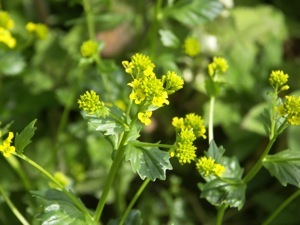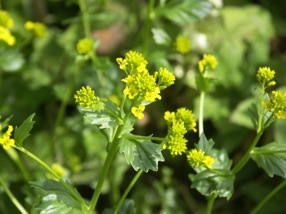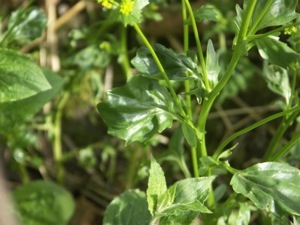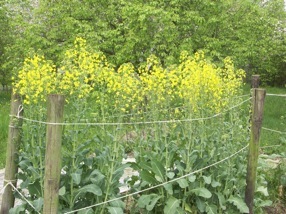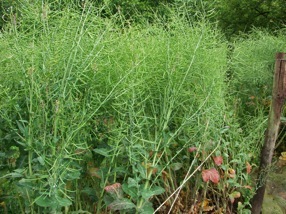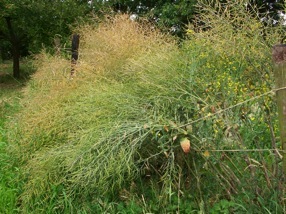
Growing Brassica Seeds
Growing seeds from all sorts of brassicas, especially cabbages is something that seems to be frightening lots of people. But, this is really not necessary, if you stick to some rules, it's in fact easy to grow out seeds (if you can spare the place , of course).
Most brassicas are biennal, so this means they need two years to form seeds, there are however some noticeable exceptions: broccolis or even early cauliflowers,, rocket or aragula and a few others grow seed in one year time, some others are even triennal or perennial.
The first thing to do is to find out what variety you have (this is mostly easy, as it's written on the seed packet), and what species this variety belongs to.
The most common grown species are brassica juncea(mustard and others), brassica napus (rutabaga, rapeand others), brassica oleracea (broccoli, cauliflower, Brussels sprouts, cabbages, kales, collards, kohlrabi), brassica rapa (turnip, broccoli raap, chinese cabbage,..), crambe maritima (sea kale), eruca sativa (rocket or aragula), raphanus sativus (radish)). These species will never cross with each other, but will cross with other varieties within the species. Thus, a broccoli will not cross with a chinese cabbage or a rutabaga, for instance, but it will cross with Brussels sprouts or collards!
So it's perfectly possible to grow out one variety of each species in order to save seeds from these.
Another thing that's really important is that brassicas are outbreeders, meaning, if you have only one lonely cauliflower that's flowering, it won't set any seeds (again, there are some lesser-grown exceptions). Two plants work, but are just a very small genetic base for seed production, so grow out at least 10 plants of each variety, more is better (10 is really an absolute minimum)
So, how to start? Just start sowing seeds from the brassicas as you would do normally, plant them out and watch them grow. Whenever winter arrives (I'm talking about the most common biennal brassicas here), make a selection: take the best plants only (and keep them apart) for seed production, and eat the smaller or different shaped ones. This is important, it's a way to select better and better plants (and seeds) for the future. Have a good look at the plants, for instance:is the variety you want seeds from originally round, and are there some flatter-shaped ones in it? Select the round ones, then, unless you want to create a 'new' flatter variety (then you should select the flat-shaped ones, off course). Depending on the climate you have, and on the cold-resistance of the brassica varieties, take them to a conservation room, or leave them in the garden. Don't eat anything from the selected plants, this is better. Take a second look after the winter: did they survive easily, did they get many rotten leaves or sicknesses,... Take, again, the good-looking healthy ones and keep these, plant them out in spring if you had to place these inside. And make sure this is the only variety within the species you will re-grow... or isolate them, as described further.
Most brassicas flower very easily , one noticeable exception is cauliflower, which needs to be cut with a knife in the middle of the plants, in a sort of X-shape. After flowering and, of course pollination by insects, seeds start to form, first on the low side of the plants, and slowly this formation will creep up to the top . Build a sturdy support around the plants, the stems loaded with seeds can fall over and you could lose a lot. It takes quite a long time for seeds to start really ripening off, I never noted it exactly, but it 's at least two months in my climate. Whenever the pods start changing colour, from green to mostly brown , and start to look a bit brittle, it's time for some action. Depending on the varieties and species, pods can suddenly burst open and shatter some seeds, so when you feel they are completely dry, take them and put them in some sort of bag. Be careful , at this ripening stage, birds can cause a lot of damage, so, if necessary, cover the plants with some sort of netting. Another cause of damage are all sorts of aphids, these can easily be taken off.
It's best to leave the pods to ripen completely on the plants, brassica seeds usually don't develop further when the stems have been cut away from the plants .
The seeds, if kept and a dry and dark room, can be used for a long time, some 4-5 years, so you can build in a sort of yearly seed-growing rotation if you want to keep on sowing different varieties from your own seeds.
Off course, there are also methods for growing out two or even three brassica varieties of the same species in one year: build some isolation cages over the brassicas, each variety gets one isolation cage, let's suppose you want to grow out three brassica oleracea varietes: red cabbage, a kale variety and Brussels sprouts. So, when you have placed the cages over the selected varieties (before flowering, off course), open up on day one the cage of the red cabbage, and keep the other two closed, on day two open up the kale cage, and keept the other ones closed, and so on... This will reduce the amount of seeds somewhat, but brassicas are mostly very prolific seed producers, a harvest of one pound of seeds from 10 plants isn't exceptional, although this depends a bit on the variety.
Another method for growing out two or more seed-brassicas is having a minimum distance between the varieties. There's lots of discussion about this one, some yell out it has to be 2 miles, at least, others speak of less than half a mile. I'm pretty sure all these persons are right... So, where do all these differences come from? First of all, insect varieties, some have a wider range than others, European honey bees for example go as far as 5 miles to pollinate (this is just an indication, because these bees aren't the main pollinators for brassicas), other hover flies or mason bees or... fly only a few hundred yards away from their homes. So, that's the first difficulty, second is a sort of physical barrier: if two brassica varieties are separated from each other with a large field of wild flowers, a big hedge, a house, ... they could perfectly well produce 'true ' seeds , even if they are only 100 foot from each other! You have to search and experiment a bit...every place has its own specific circumstances, what works in one place, could fail in another...
Some brassica varieties (I'm thinking especially about mustards and Chinese cabbages here, but there are some others) have a tendency to bolt too early, without having formed a true crop. Don't use these for seed-saving, you will only select on this early-bolting characteristic, and that's really not a good thing to do, again, follow the rule: take the best varieties....
If you want to go a bit further, you could try and start creating your own brassica variety. This is infact also easily done, but it takes time. I'll illustrate this with an example:
two brassica oleracea varieties: you have a red cabbage and a savoy cabbage, and you want to create a red cabbage with the familiar curly leaves of the savoy cabbage... grow out a line of each of these two varieties, right next to each other , and select only one plant (the best looking and healthiest, off course) from each of these two varieties. So now you have two plants that are quite close to each other, so they surely will cross-pollinate. That's the first step, the second step is sowing out the produced seeds the next year, and select again on the plants you have grown out, do this for some years, and you might end up with the curly red cabbage...But this could take some patience....

